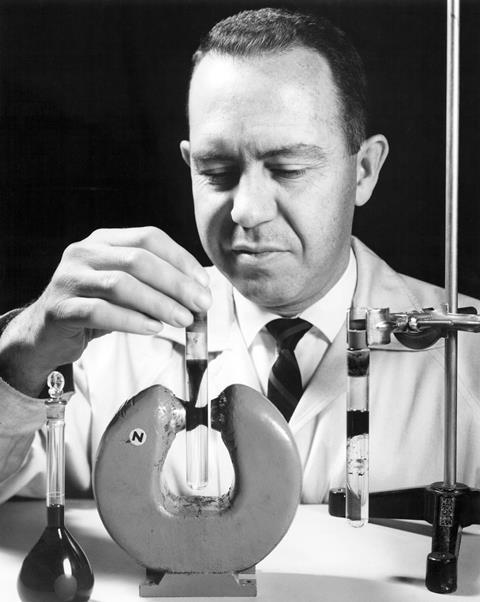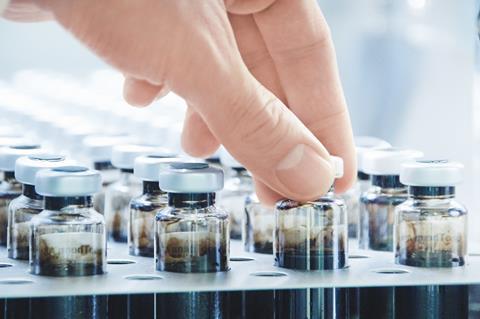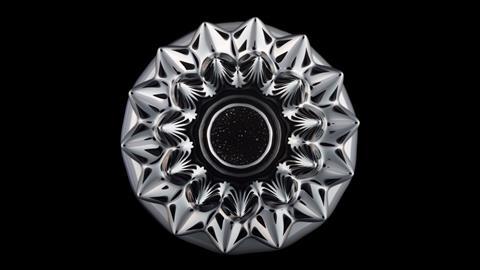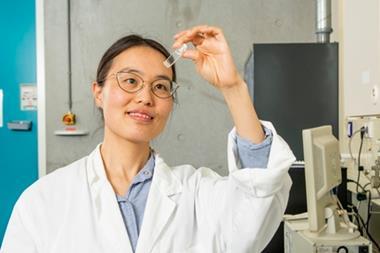Magnetic liquids are taking off, Hayley Bennett reports, but not as their inventor once imagined
Rocket scientists at the Nasa Lewis Research Center in Cleveland, US, were working day and night. It was 1963 and they were testing hundreds of different combustion chamber designs and injectors for liquid hydrogen engines, trying to iron out problems with combustion stability that could thwart efforts to put astronauts on the moon. Solomon ‘Steve’ Papell, an ex-Army Air Corps navigator turned mechanical engineer, was at Lewis at that time, working on a problem particular to liquid propellants. Back then, it wasn’t clear how liquid fuel sloshing about in zero gravity could be guided to the combustion chamber when the engine needed to be restarted. Papell attempted to solve the problem by adding magnetic dust to rocket fuel, proposing that the fuel could be drawn to the chamber using a strong magnet.

Papell’s approach worked but it never took off, so to speak. His solution meant adding ground-up iron oxide particles to the fuel and that didn’t sit well with the rocket scientists as it changed the efficiency of their rockets, explains Manfred Ehresmann, a researcher at the Institute of Space Systems at the University of Stuttgart in Germany. ‘You have non-ideal combustion because of these particles,’ says Ehresmann. ‘That’s one of the reasons it was never applied.’ However, Papell did receive a 1965 patent for his magnetic fluid, which turned out to have some intriguing properties – and not just in zero gravity.
Outside a magnetic field, a so-called ‘ferrofluid’ behaves as you might expect any liquid to behave, but if a container of it is held next to a strong magnet, its surface appears to become solid, with jagged spikes pointing along the magnetic field lines. This phenomenon is referred to as Rosensweig instability after Ronald Rosensweig, the now-retired American chemist who devoted much of his career to understanding the behaviour of ferro- and magnetic fluids. Ferrofluids can also be poured onto a magnet being levitated by a superconductor to become suspended in mid-air.
All this weirdness makes ferrofluids well-suited to showy science demonstrations and art installations, even if they didn’t make it as rocket fuels – as Ehresmann points out, most existing applications tend to be non-combustible. One widespread use in the last 40 years has been in liquid seals for rotating parts, such as in computer hard disks, where they are kept in place by magnets and give smooth, high-speed operation with very little vibration or noise. ‘A drop of fluid makes these devices possible; without that strategic drop the devices would not function,’ wrote Rosensweig in his 1985 book Ferrohydrodynamics. However, the last decade has seen scientific interest in ferrofluids rising again, with emerging uses in biomedicine, liquid robotics, plastic recycling and environmental remediation.
Magnetic medicine
A true ferrofluid is a magnetic colloid; a stable suspension of magnetic particles in an oil- or water-based carrier liquid made by milling iron oxide in a surfactant, or by chemical synthesis. The magnetic particles are small enough, usually between 3–15nm, to move by Brownian motion outside of a magnetic field and do not clump together or settle out. When drawn by a magnet, as in Papell’s proposition for pulling fuel to a combustion chamber, these tiny particles move their carrier liquid around with them, so that the suspension flows as a liquid. However, as the particles are paramagnets, the magnet does not give them long-term ordering and they go back to floating around like dust motes in air as soon as the field is removed.
The fact that these liquids can be controlled in remote fashion, using magnets, has seen them gain use in biomedical settings, explains Neil Telling, an expert in biomedical nanophysics at Keele University in Staffordshire, UK. Telling works on a much-talked-about technique called magnetic nanoparticle hyperthermia, which has long promised to lay waste to tumours deep within in the body by remotely heating up magnetic nanoparticles that then destroy the cancerous cells. ‘You supply the energy by the magnetic field,’ he says. ‘[The nanoparticles] can’t store that energy so it ends up getting released as heat.’ It’s thought cancer cells are more susceptible than healthy cells to heat, with researchers generally shooting for a few degrees above body temperature at around 40–42ºC.
One therapeutic ferrofluid called Nanotherm, developed by Berlin-based MagForce, was approved EU-wide for hyperthermia treatment of brain tumour patients in the EU in 2011, although it is currently only available in five clinics. Patients lie in an alternating magnetic field generator that focuses energy in the region of the brain where the ferrofluid is applied. A US trial in prostate cancer is also ongoing, with positive results announced in 10 patients in February this year. The technique isn’t just proposed as a cancer treatment though and, in 2019, Telling’s team successfully used it to kill the parasite that causes the disfiguring lesions in the tropical disease leishmaniasis for the first time. Most recently, in 2021, Kent State University researchers in Ohio reported clearing the amyloid plaques associated with Alzheimer’s in human brain cells.

There are, however, still issues with getting the magnetic nanoparticles to heat in the same way in real tissues as in lab tests. ‘When you actually try and use [them] in a tumour, you get a different response because of the local biological environment,’ Telling says. Part of it, he explains, is that the magnetic nanoparticles in the ferrofluid need to be tailor-made to the application – many of those tested so far have been approved for applications in magnetic resonance imaging (MRI) but are not particularly well-suited to hyperthermia.
Shape-shifting
Potential biomedical applications also rely on ferrofluids’ liquid qualities to deliver drugs and squeeze through tight spaces into biological tissues. In 2020, Hui Xie’s team at the Harbin Institute of Technology in Harbin, China, published a study showcasing liquid microrobots made from ferrofluid droplets. Their droplet robots are oil-based because they envisage applications in the watery fluids of the body, with which the droplets do not mix. They are stabilised by surface tension but reconfigured using magnetic force.
By clever programming of small electromagnet arrays (or by movements of permanent magnets), the team get their ferrofluid microrobots to split, merge, morph shape and corral delicate hydrogel balls like cattle. These skills mean they can carry liquid cargoes to demonstrate drug delivery and navigate through 4mm-wide tubes representing bile ducts or catheters. ‘A major advantage of a [ferrofluid droplet robot] is that it can squeeze through narrow spaces and enter enclosed areas with minimal damage to the surrounding environments that previous soft robots with a comparable overall size cannot reach,’ they write. However, they employ off-the-shelf ferrofluids and the distance between their robots and electromagnetic arrays is just 10mm – stronger magnets would be needed for control over greater distances.
Liquid robots would be able to respond to changes in their environment
Jitka Cejkova, a chemical robotics researcher at the University of Chemistry and Technology in Prague, Czech Republic, says one of the major advantages of liquid droplets as robots is their ability to change shape depending on their environment. Though she works with non-magnetic droplets, she takes inspiration, like the Chinese group, from nature in the form of living cells. However, she says she is ‘not a fan of ferrofluid applications in biological tissues’, suggesting that liquid droplets don’t behave in the body as they do in lab studies.
Instead, Cejkova intends to exploit her droplets’ shape-shifting abilities in environmental remediation. ‘By shape deformation or tentacle elongation, cells can reach multiple places or hardly accessible areas,’ she says. ‘This phenomenon is very inspirational for my research and the idea that liquid robots would be able to respond to changes in their environment can be used, for example, for the better uptake of harmful substances from the environment.’ She hints at grant applications in the pipeline.
Arguably, the utility of many biomedical ferrofluids may come to depend more on the characteristics of the nanoparticles themselves, which can be coated and modified with targeting molecules, than the colloids. However, in the Netherlands, ferrofluids have already found commercial application in the environmental sector and here the properties of the fluid overall are very much at play. Plastic Recycling Amsterdam uses a single-step approach to sorting plastic recycling called magnetic density separation (MDS), where flaked plastics from waste sources flow through a ferrofluid over an electromagnet. This magnet attracts the ferrofluid, setting up a density gradient within the liquid and repelling the non-magnetic flakes. ‘So inside the fluid, it’s not a simple sink/float [scenario],’ explains Utrecht University’s Ben Erné, a physical chemist who tests ferrofluids for MDS. ‘Different materials of different densities will float at different heights.’ The different fractions are then divided by splitters as they are guided out, producing high-purity nylon, polyester, polyethylene terephthalate (PET) and other plastics.
Parting plastics
For a large-scale separator, this process requires a strong magnetic field and magnetic nanoparticles that are very stably suspended in the ferrofluid so that they do not rapidly race towards the magnet and sediment out. Working with small samples, Erné’s 2020 study suggests that at 10 Teslas – stronger than the most powerful research-grade MRI systems – this is achievable with the citrate-stabilised Fe2O3 nanoparticles prepared in his lab, but he says these ideally need to be made more cheaply.
There is also currently a lack of commercially made ferrofluid for supplying large-scale MDS. ‘There’s only one company in the world that is able to produce cubic metres of ferrofluids and then you as a magnetic density separation company are dependent on their delivery times, prices, quality control, etc, so that’s why the company wants to do it itself,’ says Erné. Umincorp, the company running the Amsterdam installation, already processes the equivalent of one million residents’ plastic waste into what it claims is 99% pure plastic product that can be used ‘directly’ in new products. It aims to create ‘circular plastics’.
I was able to get really, really fine iron oxide powder from eBay
Further north, in the Dutch city of Groningen, Fionn Ferreira is working on ways to deal with the tinier scraps of plastic entering our wastewater systems. In 2019, he won the Google Science Fair prize for his concept of extracting microplastics from water using ferrofluids. Using simple, nonpolar interactions between oil and plastic, he demonstrated that he could simply lift microplastics out of polluted water with a magnet by mixing in a rough-and-ready oil-based ferrofluid. Now a chemistry student at the University of Groningen, he was at the time working in his bedroom, where he made the ferrofluid using micrometre-sized iron oxide particles – meaning it wasn’t a ‘true’ ferrofluid – and cooking oil. ‘I actually obtained iron oxide powder from eBay,’ he recalls. ‘I was able to get a really, really fine version, which, then, with a bit of guessing, tailoring and playing with different viscosities of oil, I was able to use to form a reasonably strong suspension and for my tests it then meant that I would have enough time to use it… before eventually it would break.’ It took just a bit of agitation for the microplastic fragments to become consumed by oil droplets so they could be lifted off. Ferreira wants to replicate this in an industrial process.
Working with a Footprint Coalition grant and engineering firm Stress Engineering, Ferreira says he is attempting to optimise his system to make devices that can be used to magnetically remove microplastics in wastewater treatment plants. Here, he suggests it’s still better to avoid using true ferrofluids because of the potential environmental implications associated with nanoparticles. With bigger particles of black iron oxide (Fe3O4), he says there should be little to worry about as these are common in water, aren’t soluble and can in any case be scrubbed out using magnets. There’s also another advantage to using these bigger iron oxide particles, as Fermilab physicist Arden Warner notes: ‘In terms of microplastics, you get a stronger bond because there’s more space available for the microparticles to hang onto.’
Warner leads a coalition of scientists, under the banner Natural Science, developing a device for cleaning up oil spills using magnets. His approach involves seeding spilt oil with micron-sized Fe3O4 particles to create what he calls a ‘magnetorheological fluid’. The particles are not small enough to be suspended in a Brownian fashion as in ferrofluids and there are no surfactants – avoiding applying synthetic chemicals to water – yet these fluids can still be guided by a magnetic field. Van der Waals forces are just strong enough to keep hold of the oil, allowing the magnetised fluid to behave in a surprising way. ‘These magnetic particles align themselves in the direction of the field and at right angles to it,’ says Warner. ‘The viscosity is increased, so it means that you can almost freeze it in place and lift it off the surface.’ Full-scale tests of the technology at the Oil Spill Research & Renewable Energy Test Facility in New Jersey show it to be 97% efficiency at separating oil and water. The system uses a conveyor belt to transport the oil away from the water surface and separate out iron oxide for reuse. While nanoparticulate magnetite would also work, Warner says it’s easier to get the iron oxide back out when the interactions are weaker.
Even Papell’s original proposals for ferrofluids may still fly – sort of. In 2018, a team of students led by Ehresmann sent a small sandwich box-sized test unit containing ferrofluids to the International Space Station under the auspicious project title ‘Papell‘ (pump application using pulsed electromagnets for liquid relocation). The idea was to demonstrate the utility of ferrofluids not as fuels but in non-mechanical pumping systems – in space, the fewer opportunities there are for mechanical parts to break, the better. As team member Franziska Hild explains, they connected with their small box to move ferrofluids around in tiny pipes using magnetic arrays. Such pumps could be used for long-life cooling or ventilation systems.
Ehresmann’s current project, however, is a ferrofluid-based attitude control system. Existing systems use a change in the rotation speed of a momentum wheel to change a spacecraft’s trajectory. The wheels are super-precisely produced but are still known to break down after a few years, at great expense. ‘So instead of a mechanical wheel that is turning, we use a rotating magnetic field and just have the liquid rotating in it,’ Ehresmann explains. It seems that while Papell’s ferrofluid fuels never took off, magnetic liquids haven’t lost their attraction.
Hayley Bennett is a science writer based in Bristol, UK













No comments yet